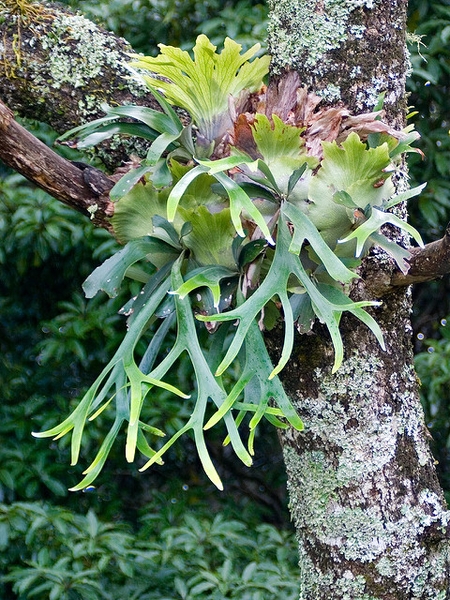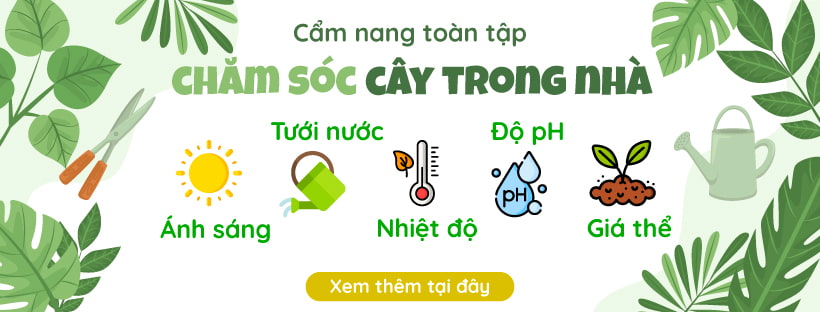Platycerium Bifurcatum
| Surname | Polypodiaceae |
|---|---|
| Origin | Australia |
| Leaf color | xanh lá |
| Shield | rounded |
| Beard | droop |
| Leaf size | vừa-lớn |
| Tăng trưởng | chậm |
| Breeding | separate |
| Diseases & Pests | spiders, aphids, root rot, leaf rot |
Platycerium Bifurcatum is a species of dragon native to eastern Australia, in New South Wales, Queensland and on Lord Howe Island. It grows up to 90 cm tall, with shields 12–45 cm long, and whiskers up to 90 cm long.
Note: The above information is only relative, the living conditions of the tree also depend a lot on other objective factors.
How to grow and care for Platycerium Bifurcatum
Platycerium Bifurcatum Plant Growing Difficulty
![]()
Difficulty: 3-4/6
Platycerium Bifurcatum is suitable for people with a little experience in plant care because:
✅ It is an epiphytic plant (not grown in soil), grows well on substrates such as coconut husk, wood, or mounted on hanging boards.
✅ No need for regular watering, drought tolerant
✅ Adapts well to indirect light and high humidity
Soil for planting Platycerium Bifurcatum plant

Platycerium Bifurcatum not grown in regular soil like other ornamental plants, which need to be mounted on a substrate to simulate treetop living conditions in the rainforest.
📌 Ideal substrate:
✅ Coconut fiber board (coir fiber or pressed soft coconut fiber)
✅ Driftwood or large tree bark
✅ Coconut fiber mesh or wooden pieces are fixed on the wall
💡 You can add sphagnum moss to keep moisture around the roots.
🚫 Do not use regular potting soil – it can easily cause waterlogging and root rot.
Suitable lighting for Platycerium Bifurcatum plant
![]()
📌 Lighting details:
✅ Best:
Platycerium Bifurcatum prefers bright indirect or diffused light. Place the plant near an east or north facing window that receives soft morning sunlight. If placed in a west or south facing window, use sheer curtains, shade nets or an awning to diffuse the light.
✅ Can withstand:
Low light for short periods, such as in a room with lamps and indirect light, but the plant will grow slowly, the leaves will be small and pale green. In these conditions, the plant will produce less new shoots.
🚫 Absolutely avoid:
Direct strong sunlight, especially at noon or in the afternoon in the West, can easily burn the edges of the leaves, especially the thin and wide “antler leaves”.
Place near a glass door without curtains or filters, where there is strong light during the day.
💡 Special Note:
- If new leaves appear yellow at the edges, dry out or curl – the plant may be suffering from sunburn.
- If the leaves grow slowly, are sparse or do not branch clearly – it is likely that the plant is lacking light.
- In spaces lacking natural light, you can use LED grow lights placed 40–50 cm away from the plants, illuminating for 10–12 hours/day.
📍 Ideal location indoors or on the balcony:
- Hang near a window with sheer curtains, an East or North facing window is optimal.
- Hanging under the porch, loggia with sunshade or large canopy above.
- Can be mounted on the wall in a room with natural light, but avoid placing under heat-emitting lamps (such as halogen lamps).
Temperature suitable for Platycerium Bifurcatum plant
![]()
🌿 Ideal temperature for Platycerium Bifurcatum plant: 18 - 27°C
📌 Features:
- Platycerium is a species epiphytic tropical fern, grows naturally in humid rainforests such as Southeast Asia, Africa and Australia.
- Climate-loving plants warm, humid year round, and very sensitive to extreme temperatures, especially deep cold or prolonged dry heat.
🚫 Inappropriate temperature:
- Below 13°C: The tree may be affected. cold shock, leading to leaf fall, softening of leaf tissue, even root damage if prolonged.
- Above 32°C (especially when humidity is insufficient): Plants wither quickly, leaf edges dry and brittle, easily leads to leaf tissue death due to excessive transpiration.
📌 Note for healthy plant growth:
✅ Avoid sudden change in temperature, such as placing the plant near an air conditioner, a draft at night, or a window where cold air blows in.
✅ Do not place plants close to heat source such as heaters, gas stoves, or places with strong sunlight shining through glass.
✅ During the days hot or dry, let's:
- Put the pot on water tray with pebbles to increase air humidity.
- Light mist early morning (avoid spraying at night to prevent fungus).
- Use Humidifier if the room has air conditioning running regularly.
📍 Signs of plants affected by temperature:
🚫 Too cold:
Leaves droop, feel soft, mushy as if waterlogged.
Leaves turn yellow from the base.
The roots stop absorbing water, even though the soil is still moist.
🚫 Too hot and dry:
Leaves lose their freshness, leaf edges curl inward or dry burn.
The leaves lose elasticity.
Spores (on the underside of the gauze) may be dry earlier than usual
Water give tree Platycerium Bifurcatum
![]()
Platycerium Bifurcatum is an epiphytic fern that lives on tree trunks or substrates, does not need soil and prefers a humid but well-ventilated environment. Plants are susceptible to waterlogging if kept too wet for long periods of time.
📌 Watering principles:
✅ Watering soaked the whole tree and growing medium (wood, bark, moss...) until water begins to drip, then let dry between waterings.
✅ Check Dryness of the substrate by hand: if it feels completely dry, gently water again.
✅ In cold weather or high humidity, should watering time extension, avoid prolonged humid environment causing root fungus or root rot.
🚫 Avoid overwatering:
- Easy to cause rot, especially at the base of the shield (the lower rounded leaf).
- Warning signs: yellow leaves, soft, slightly foul smelling, or appear white mold on the substrate.
📍 How many times a week should I water?
- Hot season (spring – summer): 2-3 times/week, depending on ventilation and light.
- Cold season (autumn – winter): Every 7–10 days or longer if the plant is hanging indoors/in poorly ventilated areas.
With the wood/moss board mounted tree, it is possible to Soak the entire board in clean water for 10–15 minutes., then hang to dry.
Humidity give Platycerium Bifurcatum plant
![]()
Platycerium grows well in environments with air humidity from 60% or higher, similar to the rainforest environment in which they naturally live. The trees are particularly sensitive to dry or cold air from air conditioning.
📌 How to maintain proper humidity:
✅ Spray light mist every morning, focusing on the underside of the gauze leaves and around the growing medium – do not spray at night.
✅ Place the tree on water tray with pebbles to increase local humidity.
✅ Use Humidifier If you put the plant in an air-conditioned room regularly.
✅ Hanging next to a group of tropical plants other to create a humid microclimate effect.
Ideal pH give Platycerium Bifurcatum plant
![]()
Platycerium Bifurcatum commonly lives bend around the substrate like wood or moss, but when mounted on a board/curtain, it can absorb nutrients from sphagnum moss or growing medium. The appropriate pH helps plants absorb nutrients effectively and prevent disease.
- Ideal pH: from 5.5 to 6.5 (some sources recommend up to 7.0, but 5.5–6.5 is best).
🌿 If the substrate is too acidic (pH < 5.5):
- Ability to absorb Mg, Ca, Fe decreases → weak plants, leaves easily turn yellow, low productivity, roots may be damaged.
🌱 If the substrate is too alkaline (pH > 7.0):
- Poor absorption of micronutrients such as Fe, Mn, Zn → can lead to dry leaf edges and slow growth.
💡 Care tips:
- Use a pH test kit to periodically check the substrate.
- If pH < 5.5: add dolomite lime or add rotten wood bark for added weight.
- If pH > 6.5–7.0: add some charcoal, sphagnum moss, or coconut fiber to adjust.
Pet-friendly
![]()
Most Platycerium species (including bifurcatum, superbum, alcicorne…) are classified as non-toxic with dogs, cats and horses.
- ✅ Tree Does not contain serious toxins, does not cause inflammation or shock if pets accidentally eat a small amount.
- ⚠️ However, leaves can cause mild irritation, vomiting, diarrhea if eaten in large amounts or due to hard fiber.
📍 Prevention:
- Hanging tree high location, out of reach of pets.
- Secure the board/wood to avoid it from falling.
- Use protective frame or mesh, if your pet has a habit of climbing or exploring.
💡 Additional notes for Platycerium Bifurcatum growers:
💡 Trees can "bleed sap" (guttation) from the edges of the gauze at night if the humidity or the substrate is too wet – this is a normal physiological phenomenon, just reduce the humidity or water more lightly.
💡 Neutral light is necessary, should rotate the board/wood hanging about 2–3 weeks/time so that the plant receives enough light, including the roots and leaves.
💡 If aphids, mold, or brown spots appear on the substrate or underside of leaves: wipe gently with wet towel Dilute some soap or use a cotton swab soaked in neem oil.
💡 Want to breed? Cut the growing medium with aerial roots or shoots, cut into moist substrate (sphagnum moss or coir) – new roots often grow back in 2–4 weeks.
💡 Use wooden boards or moss pillars Let the plant climb to help the leaves grow large and even, and create micro-humidity around the base.
Indoor Plant Care Guide
The most important and basic knowledge about growing plants indoors:








